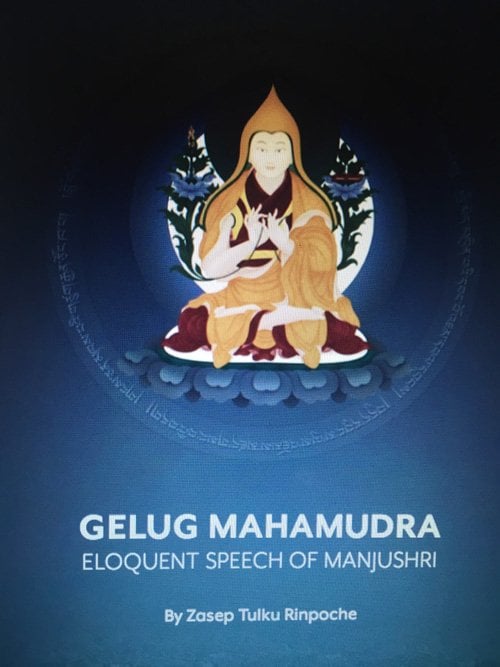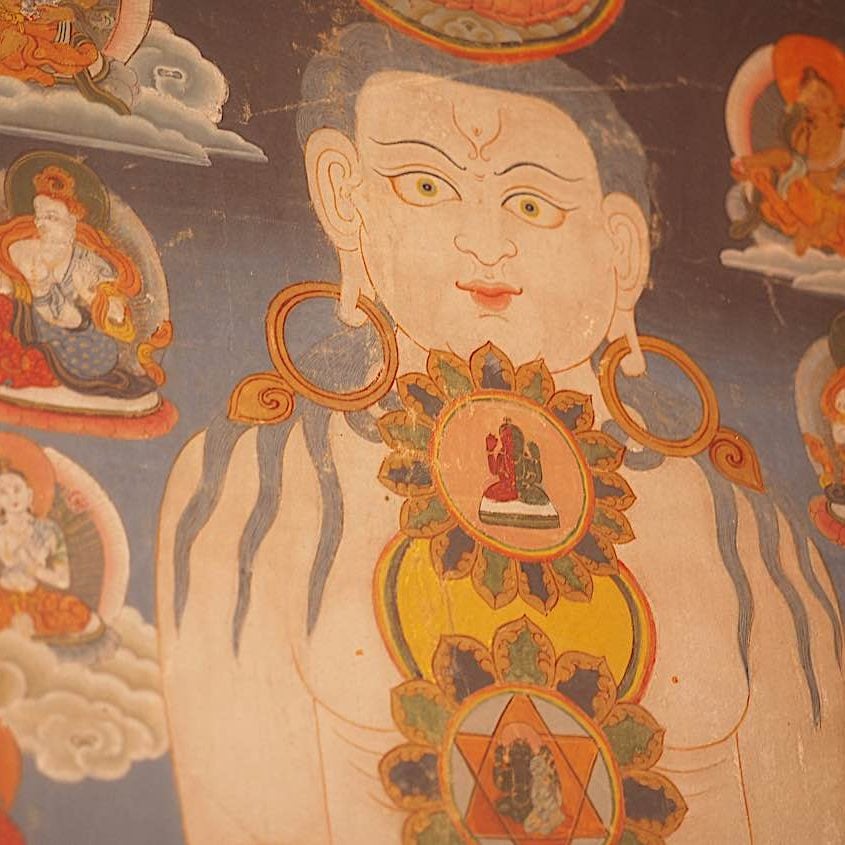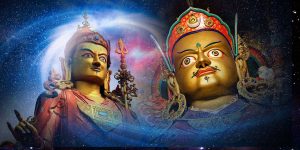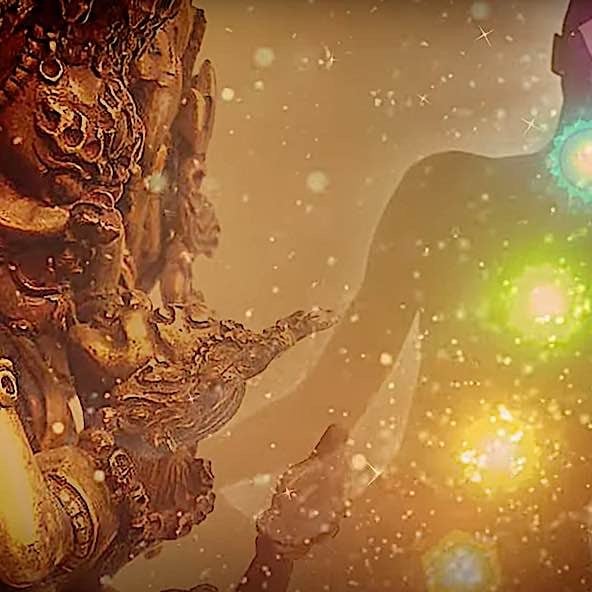Mahamudra, vast like space and beyond mind; polluted by nothing with nothing to obscure openness
Mahamudra is the ultimate practice in Tibetan Buddhism in many ways — yet it is profoundly simple. Maitripa, Tilopa’s great Mahasiddha student, described Mahāmudrā as:
“Mahāmudrā, that which is unified and beyond the mind, is clear yet thoughtless, pervasive, and vast like space. Its aspect of great compassion is apparent yet devoid of any nature. Manifesting clearly like the moon in water; It is beyond all terms, boundaries or center. Polluted by nothing, it is stainless and beyond hope and fear. It cannot be described, like the dream of a mute.” [1]
Mahamudra retreats are famous for refreshing simplicity — and, of course, jaw-dropping depth. You can think of it as Buddhist Retreat where we “retreat into our own mind.” Whether we meditate in a cave, or our bedroom is irrelevant. We stay within our mind — the subject and the object of the meditation are our own mind.

A-Ha moments
We meditate on the concepts such as “ultimate short AH” — and we have Ah-ha moments.
We abide in unobstructed openness — yet we are, somehow, observing ourselves experience that openness.
There’s more meditation than “teaching” at the retreats, yet we are still exploring. Everything seems obscure — yet unobscured.
The entire point is to remove obscurations, yet we are confronted with teaching ideas such as “Mind is emptiness, and emptiness is also mind.”
Session 1 of a Mahamudra Retreat Video Series:
Mahamudra retreat — a little more open each time we meditate
Each time I’ve attended a Mahamudra weekend retreat, I’ve left refreshed, a little more open — and, a little stretched. What do I mean by stretched? Mahamudra has a way of stretching all of your comfort points, all of your past barriers, and most of your concepts. Even when you think you understood everything — from your last two retreats — pow, something amazing happens on the next weekend.
“Unobscured openness” is how Venerable Zasep Rinpoche summarized the experience of Mahamudra.
Video Alert — Please also watch for continuing new series on the Buddha Weekly YouTube Channel, with extensive teachings in several parts from Venerable Zasep Rinpoche, recorded previously at Gaden Choling Toronto. (This is one of the retreats the author attended, and it was wonderful!) Above is video 1 in the series.

Gelug Mahamudra, Eloquent Speech of Manjushri
With permission of the author, H.E. Venerable Zasep Tulku Rinpoche, here is an excerpt from Gelug Mahamudra: Eloquent Speech of Manjushri, framing the importance of the tradition, why it is so compelling, and the lineage and source of the teaching.
Zasep Tulku Rinpoche explains Mahamudra practice
“Mahamudra meditation is awareness and understanding of the true nature of mind; it is spacious, without beginning or end. It is like observing the sky without the trace of birds, or the criss-cross of jet planes. You can merge your consciousness in the state of Mahamudra, beyond words and thoughts. The true nature of the mind is raw or naked awareness. It is an uncovered, untamed and unaltered state, without fabrication. As the great teacher Gampopa put it, “It cannot be explained intellectually, but follow the instructions of the Guru and practise according to the lineage.

Mahamudra is a practice that leads us to experience the true nature of our own mind, unmediated. The sources of the Mahamudra teaching go all the way back to the Buddha’s Prajnaparamita, or the Heart Sutra, and also to the Samadhi Raja, or the King of Concentration Sutra. In Tibetan it is known as Teng Nye Zin Gyalpoe Do. These Sutras state that the nature of all phenomena is Mahamudra. According to the Heart Sutra:
“Mind is emptiness and emptiness is also mind. There is no mind other than emptiness, no emptiness other than the mind”.
Mahamudra is the method of realizing the clear light wisdom of Shunyata and accomplishing directly and vividly what we call the ‘meaning clear light’. In its Tantric aspect, the clear light nature of the mind is called ‘ultimate short AH’. It means the uncultivated mind, the unspoiled and pure mind. As the Buddha himself said:
“Mind does not exist within the mind, but the true nature of the mind is clear light”.
Buddha’s disciple Subhuti (in Tibetan the name is Rabjor) told one of his disciples, Koshika, that if you wish to cultivate Prajnaparamita , the perfection of wisdom, you need to cultivate the yoga of space and ‘without-roof obscuration’. The yoga of spaciousness he refers to is Mahamudra, and the ultimate Mahamudra is the Dharmakaya.
Arya Subhuti was referring to the experience of Mahamudra as ‘the yoga of no obscuration’. In Tibetan we say, Lagab Medpa. This means no roof, no wall, no floor, nothing to obscure the open space. When you are out there, you see the big sky, the stars at night — unobscured spaciousness. Likewise, when you look at the true nature of the mind, Mahamudra, there is nothing to find other than the observer mind — mind without obscuration.
Generally there are two types of meditation in the Mahamudra tradition, Sutra Mahamudra (which can be divided into Samatha Mahamudra and Vipashyana Mahamudra) and Tantra Mahamudra. Samatha Mahamudra can be described as resting in the nature of mind, and Vipashyana Mahamudra can be described as clear and deep seeing.
Mahamudra practice was introduced from India to Tibet. It is a Mahayana Buddhist method of meditation known for its simplicity. The practice is to be mindful, relaxed, be here and now, accept and appreciate the opportunity for Dharma practice. The practice of Mahamudra is a peaceful experience of our inner mind that is completely free of clinging and rejection. Observing the mind’s true nature, no matter what our life brings us.
Maha means “great” and Mudra means “symbol” or “seal.” The Great Symbol referred to spacious voidness and emptiness—the very nature of our mind and all phenomena.
There are three divisions of Mahamudra 1.Ground Mahamudra, 2. Path Mahamudra, 3. Fruition Mahamudra.
Ground Mahamudra is emptiness of the mind and emptiness of all Phenomena. Path Mahamudra is the actual meditation. Fruition Meditation is the experience.
First, sit on a comfortable cushion or chair in an upright position, keeping your spine straight but in in a relaxed position, eyes look directly into the space in front. Then rest the mind in the present moment, focusing your mind on the breath. As you breath in, feel your abdomen rising and when you breath out your abdomen falling. While feeling the sensation of rising and falling, watch the inhaling and exhaling. Sit quietly for a minimum of ten minutes, gently letting go of your thoughts until you feel a sense of calmness.
Having established the stable present moment, through awareness on the breath cycle as the object of attention, now switch to space. We place the mind’s focus on spaciousness of mind as the object of attention. This space is the domain, the field of awareness in which mental events, memories, thoughts, images and so on occur.
Whatever thought comes up, whether it is negative or positive, emotional or perceptive, keep your focus on it, without judgment or comment. Rest the mind in its natural state and aim for an equilibrium state of the mind.
From time to time, reflect on the three basic characteristics of mind: emptiness, clarity, and awareness.
Tilopa’s song of Mahamudra
The clouds that wander through the sky
Have no roots, no home; nor do the distinctive
Thoughts, which float through the mind.
Once the nature of mind is seen, Discrimination stops.
In space, shapes and colours form,
But neither by black nor white is space tinged.
From the nature of mind all things emerge,
The mind is not tainted by virtues or vices.
One should not give and take but remain natural, for
Mahamudra is beyond all acceptance and rejection.
Since the consciousness is not born, no one can obstruct it or soil it;
Staying in the “Unborn” realm all appearances will dissolve into the ultimate Dharma.
At first a yogi feels his mind is tumbling like a waterfall;
In mid-course, like the Ganges, it flows on slow and gentle;
In the end, it is a great vast ocean,
Where the lights of Child and Mother merge in one.”
NOTES:
[1] Drikung Kyabgon Chetsang; Khenpo Konchok Tamphel (translator), Water Crystal: A commentary on the Ganges Mahamudra.
More articles by this author

Guru Rinpoche is ready to answer and grant wishes: “Repeat this prayer continuously” for the granting of wishes

Buddhist body mandala practice in Vajrayana Buddhism — and riding the winds of the inner body “The prana goes where the mind goes.””

4 Guardians of the World and Dharma: the Watchers of the World: the Four Heavenly Kings in Buddhism, Their Mantras and Practice
Search
Latest Features
Please support the "Spread the Dharma" mission as one of our heroic Dharma Supporting Members, or with a one-time donation.
Please Help Support the “Spread the Dharma” Mission!

Be a part of the noble mission as a supporting member or a patron, or a volunteer contributor of content.
The power of Dharma to help sentient beings, in part, lies in ensuring access to Buddha’s precious Dharma — the mission of Buddha Weekly. We can’t do it without you!
A non-profit association since 2007, Buddha Weekly published many feature articles, videos, and, podcasts. Please consider supporting the mission to preserve and “Spread the Dharma." Your support as either a patron or a supporting member helps defray the high costs of producing quality Dharma content. Thank you! Learn more here, or become one of our super karma heroes on Patreon.
Lee Kane
Author | Buddha Weekly
Lee Kane is the editor of Buddha Weekly, since 2007. His main focuses as a writer are mindfulness techniques, meditation, Dharma and Sutra commentaries, Buddhist practices, international perspectives and traditions, Vajrayana, Mahayana, Zen. He also covers various events.
Lee also contributes as a writer to various other online magazines and blogs.















